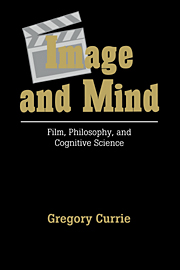Introduction: the essence of cinema
Published online by Cambridge University Press: 28 October 2009
Summary
Tired of the ponderous prescriptivism that dogged much film aesthetic (and, until recently, much aesthetics in general), film theorists frequently tell us they have put aside “essentialism”. Why bring it back? My essentialism is not especially prescriptive: no more so than the claim that water is essentially H2O. Films, like samples of water, have something in common that makes them films rather than something else. It's more than just being films, and it's more than just family resemblance. It's an essence, but knowing what that essence is doesn't help much in figuring out what films are good, typical or paradigmatic. Since the subject of this book is film, I ought to say something about the essence of film. What I say has some bookkeeping significance for what follows, but not much intrinsic interest. This is the boring part; let's get it over with. Alternatively, you can skip it and come back if and when you need to.
FILM AS REPRESENTATION
Representations come in a variety of kinds: words written and spoken, gestures established by convention or made up on the spur of the moment, pictures drawn and painted, carved or moulded shapes, smoke signals, flashed headlights, sound recordings, photographs, the projected images of film. Just about anything we do or use can be a representation, though some things are richer than others in their representational capacities; they are more apt to allow the communication of complex meanings, and what cannot be represented cannot be communicated.
- Type
- Chapter
- Information
- Image and MindFilm, Philosophy and Cognitive Science, pp. 1 - 16Publisher: Cambridge University PressPrint publication year: 1995



